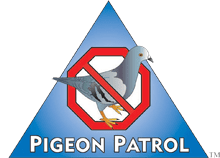
by Pigeon Patrol | May 23, 2023 | Bird Spike, Pigeon Predators, Pigeon Spikes, Pigeons, Pigeons in the News, Raccoons, Sparrows, UltraSonic Bird Control
If you are a pet bird lover or taking your baby to a house with bird pets and wondering if it’s healthy or unsafe for your child, then here is what you must know about the safety of the babies when they are around birds.
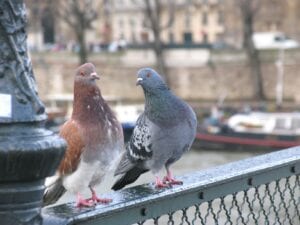
The Basics about the Problem with Birds and Babies
The birds like gulls and pigeons are categorized as pests as they spread diseases through the dust and their feathers. Pregnant women and babies are prohibited to come in contact with the birds like pigeons, gulls and parrots as they can cause sickness. Also, the transmission of some diseases from a few birds occurs through direct contact, inhaling, food contamination and some other ways.
Is Bird Dropping Toxic to Babies?
Well the below-mentioned diseases will explain everything.
Some of the Common Birds Related Diseases
Psittacosis (Parrot Fever)
Parrot fever, parrot infection or Psittacosis which is a disease related to newborn baby and parrot occurs due to bacteria called Chlamydia Psittaci. The name may point towards parrots but there are other birds too that spread parrot fever including pigeon, duck and chicken. The primary symptoms of this disease resemble that of flu. Victims may experience fever, dry and non-productive cough. Nausea, vomiting, muscle pain, diarrhea, tiredness and fatigue are some other symptoms that indicate that a person is suffering from parrot fever.
Parrot disease mainly spreads to human and people with poor immunity, elderly people, babies and pregnant women are highly prone to this disease. Also, people with respiratory issues easily get sick due to Parrot disease. Dust, feathers and cried bird droppings are the main factors that encourage the spreading of this disease.
So, if you are sick and you got birds at home then immediately consult with your doctor or health practitioner and mention that you have parrot or other pet birds at home. Doctors usually prescribe antibiotics for the treatment of parrot disease but it’s important to take precautions when you have kids at home as their immunity is comparatively weaker than the adults and they are highly prone to this disease. Make sure your baby washes his/her hands after touching the bird, the cage or the feather/droppings.
Allergic Alveolitis
Allergic Alveolitis which is commonly known as Hypersensitivity Pneumonitis is basically a lung infection where the lung is inflamed. This occurs due to the exposure to bird droppings, dust and feathers. This can also occur in the outer part of the body. Repeated exposure to these bird residues that contain fungi and bacteria causes a reaction in the body’s defence system making you sick.
Ref: https://www.sciencedirect.com/science/article/pii/B9781455733835000646
Salmonella
Salmonella infections that are commonly known as Salmonellosis spread through the feces and feathers of the birds. This infection mainly affects the intestinal tract. The symptoms of this diarrheal sickness include diarrhea, chills, fever, vomiting and abdominal cramps.
Ref: https://meridianbirdremoval.com/why-birds-cause-salmonellosis-risk/
Mycobacterium Avian Complex (MAC):
MAC usually affects people with a poor immune system. This disease is mainly caused by the organisms called M Intracellulare and M Avium. The results of this disease can be fatal sometimes.
Diseases caused by pigeons
If you see pigeons around your home and you got kids then you need to be a bit concerned about them. The common troubles faced due to pigeons are their droppings, feathers and dust spreading in the balcony. Pigeon droppings contain fungus and it affects the lungs. Make sure your laundry, especially kid’s laundry is safe is not exposed to the dust and droppings caused by the pigeons. People who have pet birds or simply pests around them generally ask a question – can my bird make pregnant women sick? Yes, they can. Prevent your baby and pregnant woman, if there is any, from getting in contact with the debris, feathers and droppings caused by the pigeons. Educate them about these birds and the health issues caused due to them.
Bird Dropping: Toxic for Humans
Bird droppings are very dangerous to human health. Here are some major hazards due to bird droppings:
E.Coli
This infection occurs due to the enteric bacteria. It is usually found in bird feces.
Candidiasis
This fungal infection is usually caused due to pigeon droppings and affects many organs like intestine, skin, mouth, respiratory system and urogenital tract.
St. Louis Encephalitis
It is a neurological disorder which may end up taking the form of paralysis.
Histoplasmosis
This lethal disease is caused due to the fungus present in bird droppings.
Salmonellosis
This disease is usually experienced when the dust and bacteria come in contact with the food through ventilation or air condition and leads to food poisoning.
The beautiful colors, enchanting sounds and humorous behaviours of birds are always adorable. There is no dearth of pet lovers and kids always fall into this vast category.
BUT, the immune system of the kids are weak and they are very vulnerable to dust and bacteria. If birds are around, dust and droppings will be a common sight but you can take measures to prevent your kids from getting exposed to these things to avoid serious illnesses.
Source
Pigeon Patrol Products & Services is the leading manufacturer and distributor or bird deterrent (control) products in Canada. Pigeon Patrol products have solved pest bird problems in industrial, commercial, and residential settings since 2000, by using safe and humane bird
deterrents with only bird and animal friendly solutions. At Pigeon Patrol, we manufacture and offer a variety of bird deterrents, ranging from Ultra-flex Bird Spikes with UV protection, Bird Netting, 4-S Bird Gel and the best Ultrasonic and audible sound devices on the market today.
Voted Best Canadian wholesaler for Bird Deterrent products ten years in a row.
Contact us at 1 877-4-NO-BIRD,(604) 585-9279 or visit our website at www.pigeonpatrol.ca
Pigeon/Pigeon Patrol / Pigeons Roosing / Vancouver Pigeon Control / Bird Spikes / Bird Control / Bird Deterrent / PIgeon Deterrent / Surrey Pigeon Control / Pest / Seagull deterrent / Vancouver Pigeon Blog / Birds Inside Home / Pigeons in the cities / Ice Pigeons / What to do about pigeons / sparrows, Damage by Sparrows, How to Keep Raccoons Away, Why Are Raccoons Considered Pests / De-fence / Pigeon Nesting / Bird Droppings / Pigeon Dropping / woodpecker control / Professional Bird Control Company / Keep The Birds Away / Birds/rats/seagull/pigeon/woodpecker/dove/sparrow/pidgeon control/pidgeon problem/pidgeon control/flying rats/pigeon problems/ bird netting/bird gel/bird spray/bird nails/bird guard
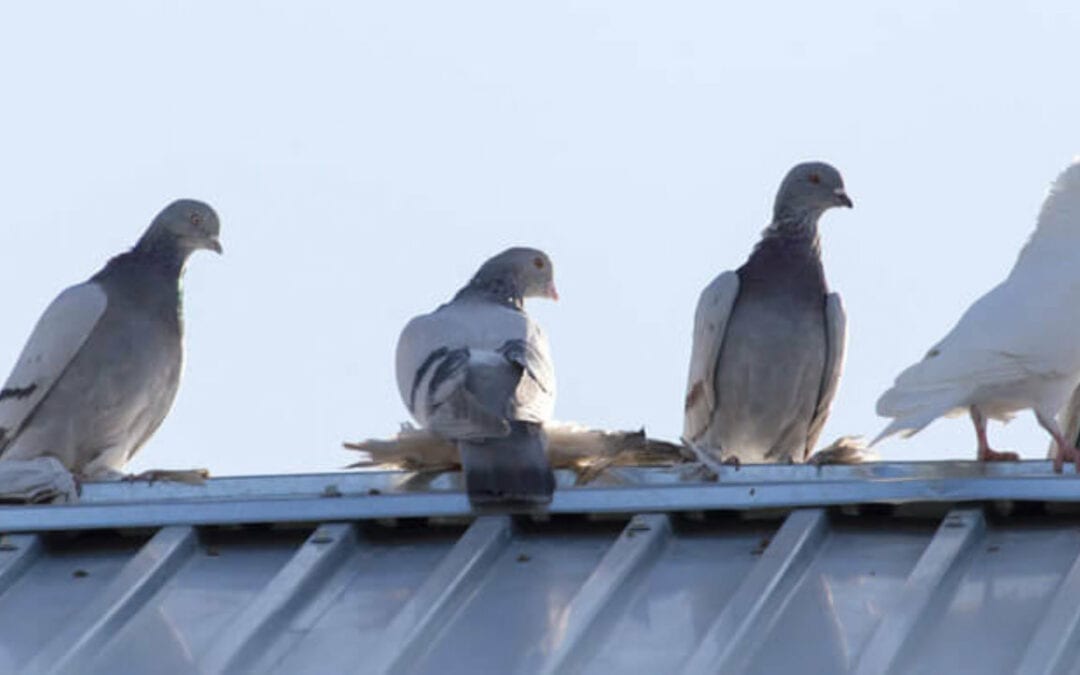
by Pigeon Patrol | May 23, 2023 | Bird Spike, Pigeon Spikes, Pigeons, Pigeons in the News, Raccoons, Sparrows, UltraSonic Bird Control
A proliferation of pigeons and their toxic poo is to blame for the current closure of the riverside walkway which runs alongside the RSC.
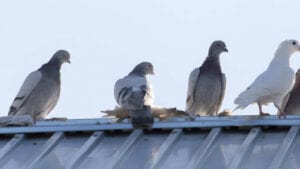
Pigeon faeces is acidic, eroding both metal and stonework, and also contains pathogens that are hazardous to humans. The inhaling of irritant airborne dust particles can cause illnesses such as ornithosis – a flu-like infection, lung inflammation, and asthma.
A theatre spokesperson explained that essential clean-up work was being done to the balconies of the dressing rooms following a “recent spate of pigeons”.
They said: “With the building being quiet over the past year – pigeons have settled and reproduced quickly producing waste which needs to be cleaned up in line with health and safety measures.”
The RSC is also taking steps to deter the pigeons from dwelling on the balconies. They explained: “We will install black netting, wires and unintrusive spikes around these areas to stop pigeons from continuing to foul the area. These are preventive measures only and will not harm any pigeons and we are working with GCB Falconry and Pest Solutions LTD to do this work.”
The walkway is expected to open today (Friday).
Source
Pigeon Patrol Products & Services is the leading manufacturer and distributor or bird deterrent (control) products in Canada. Pigeon Patrol products have solved pest bird problems in industrial, commercial, and residential settings since 2000, by using safe and humane bird
deterrents with only bird and animal friendly solutions. At Pigeon Patrol, we manufacture and offer a variety of bird deterrents, ranging from Ultra-flex Bird Spikes with UV protection, Bird Netting, 4-S Bird Gel and the best Ultrasonic and audible sound devices on the market today.
Voted Best Canadian wholesaler for Bird Deterrent products ten years in a row.
Contact us at 1 877-4-NO-BIRD,(604) 585-9279 or visit our website at www.pigeonpatrol.ca
Pigeon/Pigeon Patrol / Pigeons Roosing / Vancouver Pigeon Control / Bird Spikes / Bird Control / Bird Deterrent / PIgeon Deterrent / Surrey Pigeon Control / Pest / Seagull deterrent / Vancouver Pigeon Blog / Birds Inside Home / Pigeons in the cities / Ice Pigeons / What to do about pigeons / sparrows, Damage by Sparrows, How to Keep Raccoons Away, Why Are Raccoons Considered Pests / De-fence / Pigeon Nesting / Bird Droppings / Pigeon Dropping / woodpecker control / Professional Bird Control Company / Keep The Birds Away / Birds/rats/seagull/pigeon/woodpecker/dove/sparrow/pidgeon control/pidgeon problem/pidgeon control/flying rats/pigeon problems/ bird netting/bird gel/bird spray/bird nails/bird guard
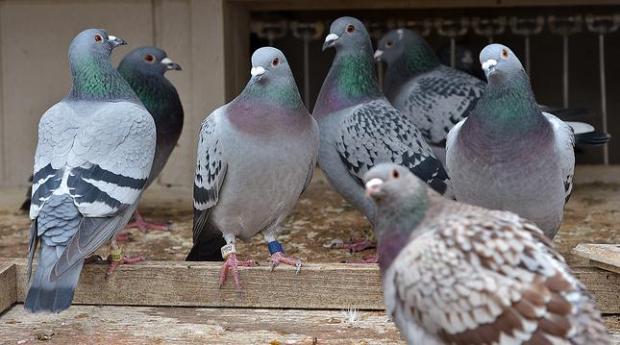
by Pigeon Patrol | May 23, 2023 | 4-S Gel Bird repellent, Animal Deterrent Products, Bird Deterrent Products, Bird Law, Bird Netting, Bird Spikes
Toronto is set to consider banning the feeding of pigeons across the city.
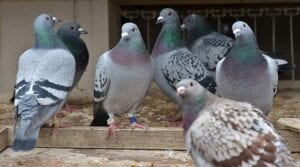
A motion proposed by Coun. Kristyn Wong-Tam seeks to prohibit the feeding of the birds in public and private spaces.
In her motion — which was to be reviewed by city council at a multi-day meeting that began Wednesday — Wong-Tam cited excessive pigeon droppings, social annoyance, property damage and the attraction of rats through discarded food scraps as reasons for the proposed ban.
“Those feeding Toronto’s pigeons may not be conscious of the adverse implications and unintended consequences resulting from their well-intended behaviour,” the motion states.
“Large flocks of birds in public and private spaces create harmful nuisance because they interfere with the enjoyment and use of public and private property.”
Sidewalks, plazas and laneways in Toronto have become “overwhelmingly inundated” with pigeons that continue to be attracted to those spaces because of food scattered by residents, the motion states.
‘Unhealthy and unsanitary conditions’
“In addition to the issues of social annoyance, excessive pigeon droppings from hundreds of birds concentrated in small areas can create unhealthy and unsanitary conditions,” the document adds.
The city already has a bylaw that bans feeding or attempting to feed wildlife in parks but that ban does not apply outside those green spaces. Wong-Tam argued in her motion that the existing bylaw has not been actively enforced.
“The lack of active and ongoing enforcement has rendered scarce green space as unusable. This is especially difficult to accept in densely populated neighbourhoods where such well-maintained and accessible parkland is desperately needed by Toronto families,” Wong-Tam said in the motion.
The motion recommends the municipal licensing and standards executive director report back to council next March on a possible pigeon-feeding ban.
That report would include exploring the feasibility of prohibiting pigeon-feeding in all public and private spaces in the city, and look at what kind of requirements would be needed to begin a “rapid-response investigation and enforcement” to prioritize any 311 complaints about pigeon feeding.
Another point the executive director would have to address, if the motion passes, would be consultations with Toronto Public Health while developing health and safety strategies “to address unsanitary conditions due to excessive amounts of droppings when pigeons are gathered in large numbers.”
Source
Pigeon Patrol Products & Services is the leading manufacturer and distributor or bird deterrent (control) products in Canada. Pigeon Patrol products have solved pest bird problems in industrial, commercial, and residential settings since 2000, by using safe and humane bird
deterrents with only bird and animal friendly solutions. At Pigeon Patrol, we manufacture and offer a variety of bird deterrents, ranging from Ultra-flex Bird Spikes with UV protection, Bird Netting, 4-S Bird Gel and the best Ultrasonic and audible sound devices on the market today.
Voted Best Canadian wholesaler for Bird Deterrent products ten years in a row.
Contact us at 1 877-4-NO-BIRD,(604) 585-9279 or visit our website at www.pigeonpatrol.ca
Pigeon/Pigeon Patrol / Pigeons Roosing / Vancouver Pigeon Control / Bird Spikes / Bird Control / Bird Deterrent / PIgeon Deterrent / Surrey Pigeon Control / Pest / Seagull deterrent / Vancouver Pigeon Blog / Birds Inside Home / Pigeons in the cities / Ice Pigeons / What to do about pigeons / sparrows, Damage by Sparrows, How to Keep Raccoons Away, Why Are Raccoons Considered Pests / De-fence / Pigeon Nesting / Bird Droppings / Pigeon Dropping / woodpecker control / Professional Bird Control Company / Keep The Birds Away / Birds/rats/seagull/pigeon/woodpecker/dove/sparrow/pidgeon control/pidgeon problem/pidgeon control/flying rats/pigeon problems/ bird netting/bird gel/bird spray/bird nails/bird guard
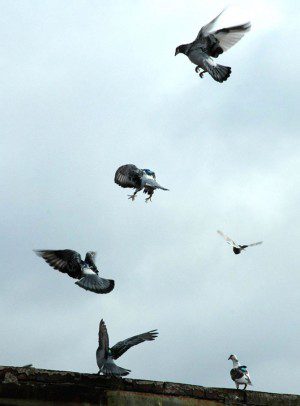
by Pigeon Patrol | May 23, 2023 | Bird Spike, Pigeon Droppings, Pigeon Patrol's Services, Pigeon Predators, Pigeon Spikes, Pigeons, Pigeons in the News
Pigeons are always on the lookout for a source of food and buildings with plenty of high nooks and crannies to roost and nest in, and your factory might just fit the bill.
But if pigeons get into your factory, it’s a serious problem. These pest birds and their guano (poo) carry and spread some nasty diseases, and they can also damage property. This is bad news for any business, but if food is manufactured, packaged, and stored in your factory, it can be disastrous.
Before your reputation and your profits take a serious hit, read our advice on how you can keep pigeons out of your factory.
How to prevent pigeons from getting into your factory
First, eliminate any sources of food
Any sources of food will be very attractive to pigeons, and eliminating them will make your factory less desirable to roost or nest in. Keep your factory scrupulously clean and don’t leave food ingredients or waste lying around, inside or outside of the premises.
It’s also a good idea to talk to nearby businesses if their poor waste management or housekeeping practices are attracting pest birds to the vicinity.
Second, use deterrents
When you are trying to prevent pigeons from nesting or roosting in or on your property, deterrents like bird spikes, bird wire, and netting can be effective at keeping them at bay.
Third, fix up your factory
If there are holes in your factory roof or walls that you haven’t got around to fixing, you could inadvertently be providing pigeons with the perfect nesting place. Make sure you fix them up-deterring pigeons is all about making your factory much less attractive to them.
Finally, deal with the guano
As we mentioned earlier, pigeon droppings can contain some harmful bacteria, so we would recommend that you don’t try to clean it up yourself.
If pest pigeons have made a mess of your factory, call in the professionals. We will blast away guano with the right equipment and products so your premises is clean, safe, and hygienic again.
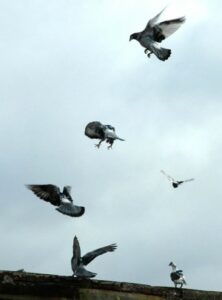
Do I need professional pigeon control for my factory?
As birds are protected by the Wildlife and Countryside Act 1981, it’s illegal to poison or shoot them if you don’t have a license. If you put poison down, you could harm other birds and end up in legal trouble. And not only that, if you’re a food business, you won’t be able to use toxic bird control methods anyway as you could contaminate your product.
If you hire professional pest control, you can get your pest problem dealt with fast. We can deal with any existing infestation, install effective bird-proofing and deterrents, and give you expert advice on preventing any problems in the future.
Source
Pigeon Patrol Products & Services is the leading manufacturer and distributor or bird deterrent (control) products in Canada. Pigeon Patrol products have solved pest bird problems in industrial, commercial, and residential settings since 2000, by using safe and humane bird
deterrents with only bird and animal friendly solutions. At Pigeon Patrol, we manufacture and offer a variety of bird deterrents, ranging from Ultra-flex Bird Spikes with UV protection, Bird Netting, 4-S Bird Gel and the best Ultrasonic and audible sound devices on the market today.
Voted Best Canadian wholesaler for Bird Deterrent products ten years in a row.
Contact us at 1 877-4-NO-BIRD,(604) 585-9279 or visit our website at www.pigeonpatrol.ca
Pigeon/Pigeon Patrol / Pigeons Roosing / Vancouver Pigeon Control / Bird Spikes / Bird Control / Bird Deterrent / PIgeon Deterrent / Surrey Pigeon Control / Pest / Seagull deterrent / Vancouver Pigeon Blog / Birds Inside Home / Pigeons in the cities / Ice Pigeons / What to do about pigeons / sparrows, Damage by Sparrows, How to Keep Raccoons Away, Why Are Raccoons Considered Pests / De-fence / Pigeon Nesting / Bird Droppings / Pigeon Dropping / woodpecker control / Professional Bird Control Company / Keep The Birds Away / Birds/rats/seagull/pigeon/woodpecker/dove/sparrow/pidgeon control/pidgeon problem/pidgeon control/flying rats/pigeon problems/ bird netting/bird gel/bird spray/bird nails/bird guard

by Pigeon Patrol | May 18, 2023 | Bird Spike, Pigeon Predators, Pigeon Spikes, Pigeons, Pigeons in the News, Raccoons, Sparrows, UltraSonic Bird Control
NICK OUD knows when to put his faith in a bird. As he clasps a homing pigeon between his hands, he looks for three things: curiosity, toughness, and stubbornness. A bird with these qualities is likely to go the distance. His benchmark is a remarkable hen named Lady Hearst, who won a mammoth 800-kilometre race in 2015.

Bird droppings on building window
The odyssey started in Hearst, Ontario, a town of about 5,000 people off the Trans-Canada Highway between Thunder Bay and Timmins. It began, as all pigeon races do, with a trailer resembling a wall of PO boxes. In it were 426 birds, ready to race the hundreds of kilometres back to their homes. For Lady Hearst, that challenge boiled down to an eleven-hour trailer ride northwest to a place she had never been before with seemingly no opportunity to get her bearings. Once released, she had to contend with the uniform terrain of rocks and trees that makes up part of the Canadian Shield.
Pigeon racing can be a brutal sport. Beyond the sheer length of the races, incidents of doping, mass deaths, and illegal gambling have detracted from what should be an exhibition of an animal’s incredible skill. While the Canadian racing scene is lower profile than its cutthroat counterparts in the UK, South Africa, and the United States, the challenge for the birds remains the same.
Nonetheless, Oud’s hen made the journey look like a cinch. She took flight from Hearst and made a beeline south to her home, just outside of Delhi, Ontario. After fourteen hours on the wing, she flew straight through the one-way door on the outside of Oud’s loft, finishing in first place. From that point on, she was Oud’s star hen.
Oud has had no shortage of practice selecting the perfect racing bird. One of his first memories after emigrating from the Netherlands to the township of Wainfleet, Ontario, was of nabbing a pigeon off of his roof and building it a loft out of the wooden crate that had carried his belongings to Canada. “We didn’t know any better,” Oud says. “We just grabbed the pigeon [and then realized] now we don’t have a loft for it.” Over time, he noticed that the pigeon would return to its crate-turned-loft no matter how far it strayed. That revelation changed his life.
While Oud, now seventy-five, knows when a bird is strong enough to make such a journey, he couldn’t say why she does it—or how. From around 2000 BCE, when it’s thought that ancient Sumerians discovered pigeons’ amazing homing abilities, to now, we still don’t quite know how these birds orient themselves in the sky. Scientists have various theories, but they have yet to fully understand the phenomenon. “It’s a mystery,” Oud says. “It’s part of what makes the sport so interesting.”
While Oud is content to live with that mystery, the stakes are much higher for bird researchers. Comprehending how these animals find their way home could help us understand more about the animal kingdom. “Animals are very similar, at least across vertebrates,” says Elizabeth Gow, a migration scientist formerly with Birds Canada. “If you find something out about one group of animals, it could be the same across other animals.”
FOR CHARLES WALCOTT, cracking the mystery of avian navigation has been a goal since the 1960s. Now a professor emeritus at Cornell University’s department of neurobiology and behaviour, Walcott has been fascinated by homing pigeons ever since a graduate student approached him with a problem. The pupil had developed an attachable radio transmitter to track the movements of birds, but the seagulls he had been attempting to use weren’t cooperating. They would take off with the contraption, fly to the city dump, and stay there. Walcott suggested he use homing pigeons instead of seagulls so that the student wouldn’t keep losing transmitters. So intrigued was Walcott by the student’s research project that he then took an extraordinary step. To track the pigeons while they flew in real time, Walcott learned to fly a Cessna 180.
“I have several thousand hours of flight time, all in circles following homing pigeons on their way home,” he says. “Apparently [the pattern] is quite distinct on radar, so the air traffic people would know what we were up to and give us a hard time.”
For scientists, there is no shortage of migration puzzles to be solved. “Monarch butterflies manage to fly all the way down [from Canada] to Mexico to spend the winter,” says Walcott. “Then, the next spring, they come up and they go to Texas and have a brood, and then they go farther north and have another brood. By the time they get to Canada, they’re probably three generations away from the ones that overwintered in Mexico. Suddenly, generation four turns around, and they’re able to fly back to that one little spot in Mexico.” Whales and caribou are two other species with lengthy migrations made possible by faculties still unknown to humans. “It’s a general problem to which we really don’t have a very good answer.”
Walcott’s work involves isolating the different “compasses” that pigeons and other species use to navigate. Three key types, he explains, are the earth’s magnetic field, the sun, and the stars. These seem to generally occur throughout the animal kingdom, he explains, though pigeons do not rely on stars because they sleep at night. But then there are other mechanisms. Walcott says that salmon somehow know to return to the streams where they first hatched. Scientists have confirmed that the fish can sniff their way around their birth stream once they get there, but as Walcott says, “Do you suppose you can really smell the Columbia River out in the middle of the Pacific Ocean? Yeah, I doubt it. I think there’s something else going on.”
While most migratory birds use a variety of compasses, the feats of pigeons differ from, say, the biannual migration of the yellow warbler. For one, migratory birds use flight paths to travel north and south. Each year that they make the trip, they take a similar route. Racing pigeons like Lady Hearst don’t have that luxury. They’re transported to a completely foreign environment and still somehow find their way back home.
Even with many a day spent over Ithaca, New York, monitoring the travels of homing pigeons, Walcott is stumped. “If you take a pigeon someplace where it’s never been before, the first thing it has to do is figure out what direction is home, and [how they do] that is still mysterious,” Walcott says. Italian scientists say it’s olfaction, but many German scientists believe it’s the earth’s magnetic field. “And then there’s a fellow in California, Jonathan Hagstrum, who says it’s low-frequency sound,” Walcott adds. “My suspicion is that maybe it’s all of the above.”
Gow, the bird-migration scientist, says that all of these theories hold water. “Birds can hear much differently than we can: they hear much higher frequencies and much lower frequencies,” she says. “The sounds emitted by the earth have very low frequencies, so the theory is that pigeons are able to detect those low-frequency sounds.”
A long-held view was that birds were aided in their orientation by a cluster of iron neurons in their beaks, which interacted with the earth’s magnetic field. “But, in the past ten years, people have begun to ask if maybe it’s something else.” Gow posits that this something could well be olfaction. “If you have a colony of birds,” she says, “they can find their individual nest among thousands by smell.”
We may consider them flying rats, but pigeons are smarter than many think. “A lot of these birds have developed a very large hippocampus, which is the part of the brain associated with memory and learning,” Gow says. Although racing birds are bred to enhance their homing capabilities, Gow believes that even common street pigeons can find their way home. “If you were to take a pigeon off the streets of Toronto and take it 500 kilometres away, it could probably find its way back.”
AS THE SUN breaks over the horizon, casting its rays on the fields and forests of rural southern Ontario, Oud unloads four wooden cages packed with pigeons from the back of his silver hatchback. He has selected birds he believes have strong homing qualities and driven them two kilometres from home for their first test flight. He extends their range farther and farther until he feels that they’re adequately prepared to race. “I can tell when they’re ready,” Oud says. “All of a sudden, one day I let ’em out of the basket, and instead of spending time circling and trying to figure out which way, boom, they’re gone.”
As for Lady Hearst, she moved to the breeding loft after her win in 2015. Since then, Oud estimates that she has bred two or three more race winners. She doesn’t lay anymore, but Oud makes sure she remains comfortable.
When Oud walked out of his front door in Wainfleet in the early ’60s, he let his pigeon out knowing it would return but not knowing why. At a time when we think we have it all figured out, it can be humbling to be so vexed by a quandary surrounding a bird that has been tamed, used, and studied by humans for at least 3,000 years. Reflecting back on six decades in the sport and why that first resident of his makeshift loft always returned home, Oud takes a less scientific approach. “It was just understood.”
Source
Pigeon Patrol Products & Services is the leading manufacturer and distributor or bird deterrent (control) products in Canada. Pigeon Patrol products have solved pest bird problems in industrial, commercial, and residential settings since 2000, by using safe and humane bird
deterrents with only bird and animal friendly solutions. At Pigeon Patrol, we manufacture and offer a variety of bird deterrents, ranging from Ultra-flex Bird Spikes with UV protection, Bird Netting, 4-S Bird Gel and the best Ultrasonic and audible sound devices on the market today.
Voted Best Canadian wholesaler for Bird Deterrent products ten years in a row.
Contact us at 1 877-4-NO-BIRD,(604) 585-9279 or visit our website at www.pigeonpatrol.ca
Pigeon/Pigeon Patrol / Pigeons Roosing / Vancouver Pigeon Control / Bird Spikes / Bird Control / Bird Deterrent / PIgeon Deterrent / Surrey Pigeon Control / Pest / Seagull deterrent / Vancouver Pigeon Blog / Birds Inside Home / Pigeons in the cities / Ice Pigeons / What to do about pigeons / sparrows, Damage by Sparrows, How to Keep Raccoons Away, Why Are Raccoons Considered Pests / De-fence / Pigeon Nesting / Bird Droppings / Pigeon Dropping / woodpecker control / Professional Bird Control Company / Keep The Birds Away / Birds/rats/seagull/pigeon/woodpecker/dove/sparrow/pidgeon control/pidgeon problem/pidgeon control/flying rats/pigeon problems/ bird netting/bird gel/bird spray/bird nails/bird guard


